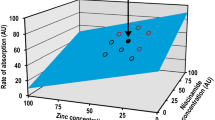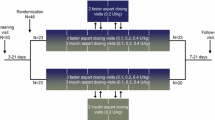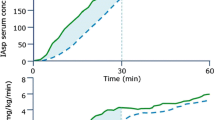Abstract
Since the approval of bolus insulin, it has been used frequently in clinical practice for the management of type 1 and 2 diabetes mellitus for postprandial control. Another new product is faster insulin aspart (Fiasp, Novo Nordisk), a fast-acting insulin with 100 units/mL. Several studies have been conducted evaluating the pharmacokinetics and pharmacodynamics of faster insulin aspart, compared with insulin aspart. This new bolus insulin provides greater glucose-lowering effect at 20 min, following subcutaneous administration. Faster insulin aspart had a greater reduction in hemoglobin A1c concentrations from baseline in patients with type 1 diabetes mellitus when compared with insulin aspart, whereas the two bolus insulins were similar in this outcome in patients with type 2 diabetes mellitus. Depending on the trial, the safety profile may differ between these two insulins with severe or confirmed hypoglycemia. Based on the clinical evidence for efficacy and safety, faster insulin aspart can be considered a viable option for those patients with type 1 and 2 diabetes mellitus who desire to inject immediately prior to a meal or within 20 min following a meal. However, additional studies should be completed to determine the role of faster insulin aspart in pregnant and pediatric patients, along with patients prescribed insulin pumps. This article evaluates and summarizes the pharmacokinetics and pharmacodynamics of faster insulin aspart for patients with type 1 or 2 diabetes mellitus, and summarizes its application to clinical practice.
Similar content being viewed by others
References
World Health Organization. Diabetes. http://www.who.int/mediacentre/factsheets/fs312/en/. Accessed 17 Jan 2018.
Centers for Disease Control. National diabetes statistics report, 2017. https://www.cdc.gov/diabetes/pdfs/data/statistics/national-diabetes-statistics-report.pdf. Accessed 17 Jan 2018.
Centers for Disease Control. Diabetes public health resource: age-adjusted percentage of adults with diabetes using diabetes medication, by type of medication, United States, 1997–2011. https://www.cdc.gov/diabetes/statistics/meduse/fig3.htm. Accessed 17 Jan 2018.
American Diabetes Association. Pharmacologic approaches to glycemic control: standards of medical care in diabetes. Diabetes Care. 2018;41(Suppl 1):S73–85.
Garber AJ, Abrahamson MJ, Barzilay JI, et al. AACE/ACE comprehensive diabetes management algorithm. Endocr Pract. 2018;24(1):91–120.
Novolog (insulin aspart): prescribing information. Bagsvaerd: Novo Nordisk; 2017.
Humalog (insulin lispro): prescribing information. Indianapolis: Eli Lilly and Company; 2017.
Apidra (insulin glulisine): prescribing information. Bridgewater: Sanofi; 2017.
Fiasp (insulin aspart) prescribing information. Bagsvaerd: Novo Nordisk; 2017.
Russell-Jones D, Bode BW, De Block C, et al. Fast-acting insulin aspart improves glycemic control in basal–bolus treatment for type 1 diabetes: results of a 26-week multicenter, active-controlled, treat-to-target, randomized, parallel-group trial (onset 1). Diabetes Care. 2017;40(7):943–50.
Mathieu C, Bode BW, Franek E, Philis-Tsimikas A, Ludger R, Graungaard T, et al. Efficacy and safety of fast-acting insulin aspart in comparison with insulin aspart in type 1 diabetes (onset 1): a 52-week, randomized, treat-to-target, phase III trial. Diabetes Obes Metab. 2018;20(5):1148–55.
Bowering K, Case C, Harvey J, et al. Faster aspart versus insulin aspart as part of a basal–bolus regimen in inadequately controlled type 2 diabetes: the Onset 2 Trial. Diabetes Care. 2017;40(7):951–7.
Rodbard HW, Tripathy D, Vidrio VM, et al. Adding fast-acting insulin aspart to basal insulin significantly improved glycaemic control in patients with type 2 diabetes: a randomized, 18-week, open-label, phase 3 trial (onset 3). Diabetes Obes Metab. 2017;19(1):1389–96.
Heise T, Hövelmann U, Brøndsted L, et al. Faster-acting insulin aspart: earlier onset of appearance and greater early pharmacokinetic and pharmacodynamic effects than insulin aspart. Diabetes Obes Metab. 2015;17:682–8.
Heise T, Pieber TR, Danne T, Erichsen L, Haahr H. A pooled analysis of clinical pharmacology trials investigating the pharmacokinetic and pharmacodynamic characteristics of fast-acting insulin aspart in adults with type 1 diabetes. Clin Pharmacokinet. 2017;56(5):551–9.
Heise T, Zijlstra E, Nosek L, LicEng TR, Haahr H. Pharmacological properties of faster-acting insulin aspart versus insulin aspart in patients with type 1 diabetes receiving continuous subcutaneous insulin infusion: a randomized double-blind, crossover trial. Diabetes Obes Metab. 2017;19(2):208–15.
Heise T, Hövelmann U, Zijlstra E, et al. A comparison of pharmacokinetic and pharmacodynamic properties between faster acting insulin aspart and insulin aspart in elderly subjects with type 1 diabetes mellitus. Drugs Aging. 2017;34(1):29–38.
Fath M, Danne T, Biester T, et al. Faster-acting insulin aspart provides faster onset and greater early exposure vs insulin aspart in children and adolescents with type 1 diabetes mellitus. Pediatr Diabetes. 2017;18:903–10.
Zijlstra E, Demissie M, Graungaard T, et al. Investigation of pump compatibility of fast-acting insulin aspart in subjects with type 1 diabetes. J Diabetes Sci Technol. 2018;12(1):145–51.
Hövelmann U, Heise T, Nosek L, et al. Pharmacokinetic properties of fast-acting insulin aspart administered in different subcutaneous injection regions. Clin Drug Investig. 2017;37(5):503–9.
Klonoff D, Evans M, Lane W, et al. Efficacy and safety of continuous subcutaneous insulin infusion of faster aspart compared with insulin aspart in type 1 diabetes. Poster presented at advanced technologies and treatments for diabetes; 14–17 Feb 2018: Vienna.
Author information
Authors and Affiliations
Corresponding author
Ethics declarations
Funding
No external funding was used in the preparation of this manuscript.
Conflict of interest
Ms. Abigayle Davis, Ms. Jolly Kuriakose, and Dr. Jennifer Clements declare they have no conflicts of interest that might be relevant to the contents of this manuscript.
Rights and permissions
About this article
Cite this article
Davis, A., Kuriakose, J. & Clements, J.N. Faster Insulin Aspart: A New Bolus Option for Diabetes Mellitus. Clin Pharmacokinet 58, 421–430 (2019). https://doi.org/10.1007/s40262-018-0696-8
Published:
Issue Date:
DOI: https://doi.org/10.1007/s40262-018-0696-8




